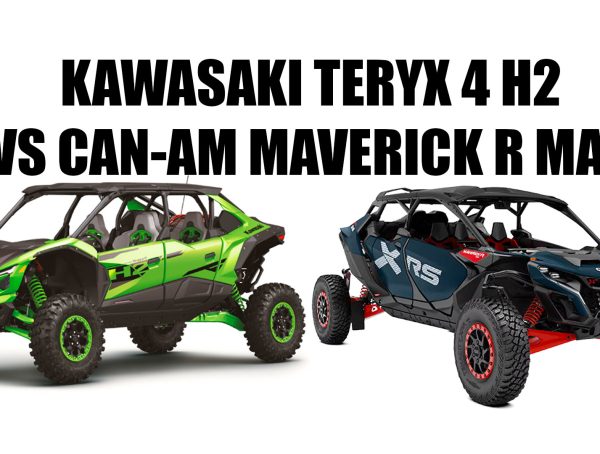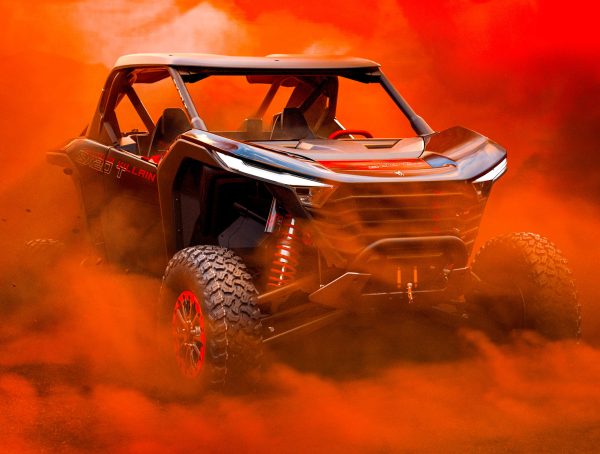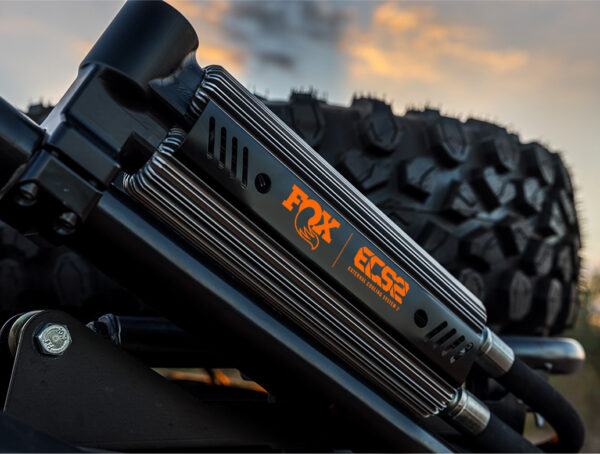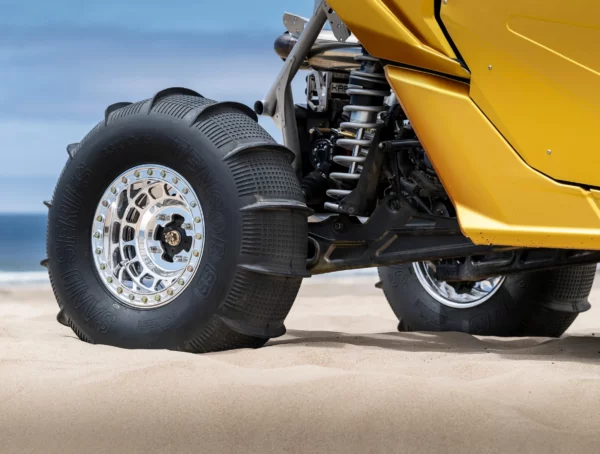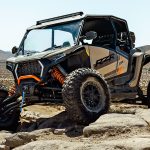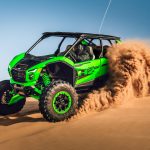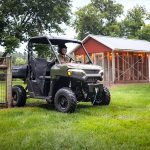We have long posted about the market demand for a supercharged side-by-side in the market. The aftermarket has even been bringing the power with bolt-on belt driven supercharger options for many makes and models. Following this desire for bigger power, we’ve been scouring the information pipelines for a Kawasaki supercharged option, especially with their landmarks in the super bike market. After years of patent posting and rumor vetting, Kawasaki proves to the market that the overseas manufacturers can actually deliver on customer demand and today team green dropped the all-new 2026 Kawasaki Teryx H2 lineup of UTVs!
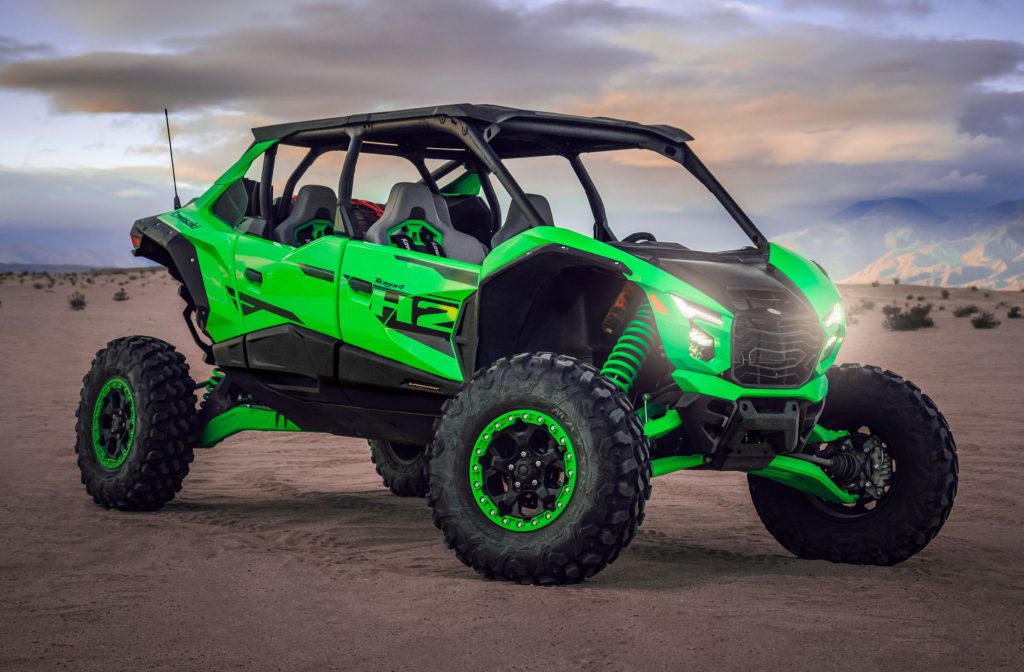
The all-new Kawasaki Teryx 4 H2 comes in three flavors. The base model Teryx 4 H2 has an MSRP of $37,199 USD and is the entry level trim without all of the accessories and electronics of the eS trims. The Teryx 4 H2 Deluxe eS trim MSRP’s at $43,199 and adds the Kawasaki Electronic Control Suspension (KECS) with acceleration sensors, selectable drive power modes, the 10″ Garmin Tread navigation and infotainment interface, along with some accessories like the roof and color matched suspension. For the first time in this segment, Kawasaki is also offering a new Teryx 5 trim variant that includes a 3-seat bench seat in the second row. This will be great for large or growing families!
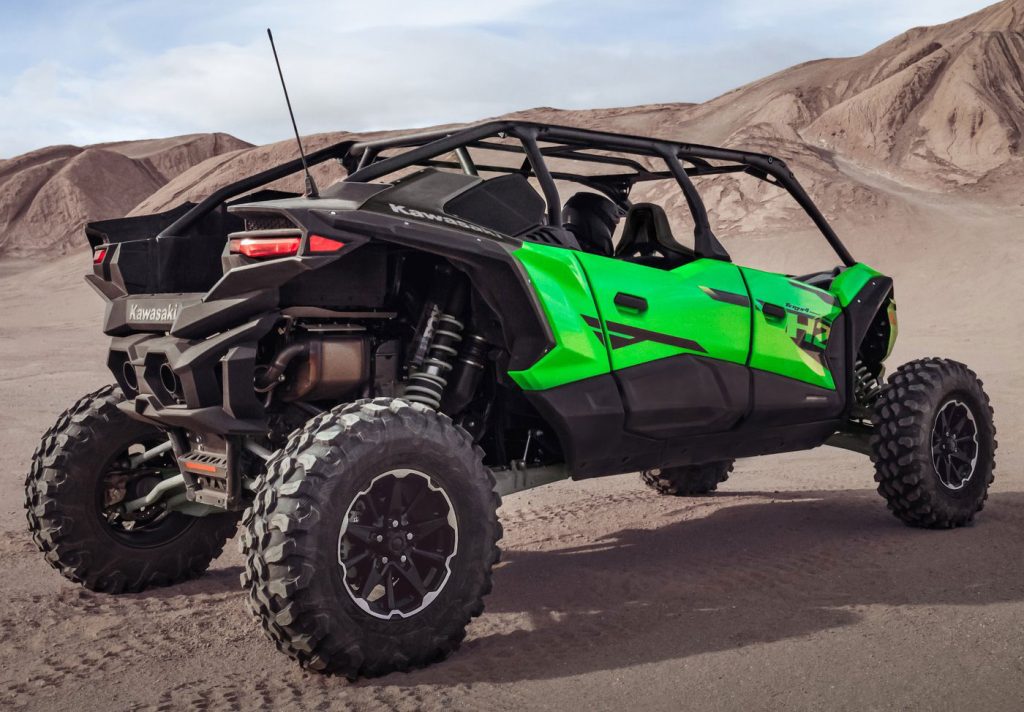
2026 Kawasaki Teryx 4/5 H2 Specs
| Teryx Spec | 4 H2 | 4 H2 Deluxe eS | 5 H2 Deluxe eS |
|---|---|---|---|
| MSRP (USD) | $37,199 | $43,199 | $43,699 |
| Engine | 999cc Supercharged In-Line 4-Cylinder | ||
| Total Horsepower | 250 hp* (ISO Standard 4106, not SAE) | ||
| Fuel System | DFI® with 4x40mm Throttle Bodies & Dual Injection | ||
| Transmission | CVT w/ Centrifugal Clutch, H/L/N/R | ||
| Drive | Electronically Selectable 2WD, 4WD, Front Locked 4WD | ||
| Drive Power Modes | Full (100%), Mid (80%), & Low (60%) | ||
| Seating | 4 Buckets | 2 Front Buckets 3-Person Bench Rear | |
| Curb Weight | 2,425.5 lb | 2,496.1 lb | 2,507.1 lb |
| Wheelbase | 126″ | ||
| Dimensions (L x W x H) | 159.4″ x 74″ x 71.5″ | ||
| Max Ground Clearance | 16.5″ | ||
| Wheel Travel | 23.2″ Front / 24″ Rear | ||
| Wheels | 16″ 5-Lug Aluminum Bead-Lock | ||
| Tires | Maxxis Carnivore Plus 33x10r16 | ||
| Front Suspension | Dual A-Arm | ||
| Rear Suspension | 4-Link Trailing-Arm | ||
| Turning Radius | 24.9 ft | ||
| Bed Dimensions (L x W x H) | 14.6″ x 33.1″ x 9.1″ | ||
| Bed Capacity | 300 lb | ||
| Payload Capacity | 1,076 lb | ||
| Fuel Capacity | 14.8 gal | ||
| Winch Included | None | ||
| Gauge Cluster | 7″ Full-Color TFT Cluster w/ Bluetooth | ||
| Infotainment/Navigation | None | 10″ Garmin Tread | |
| Colors | Lime Green | ||
| Standard Warranty | 6 Month Limited | ||
| Available Warranty | 12, 24, or 36 Month Kawasaki Protection Plus | ||
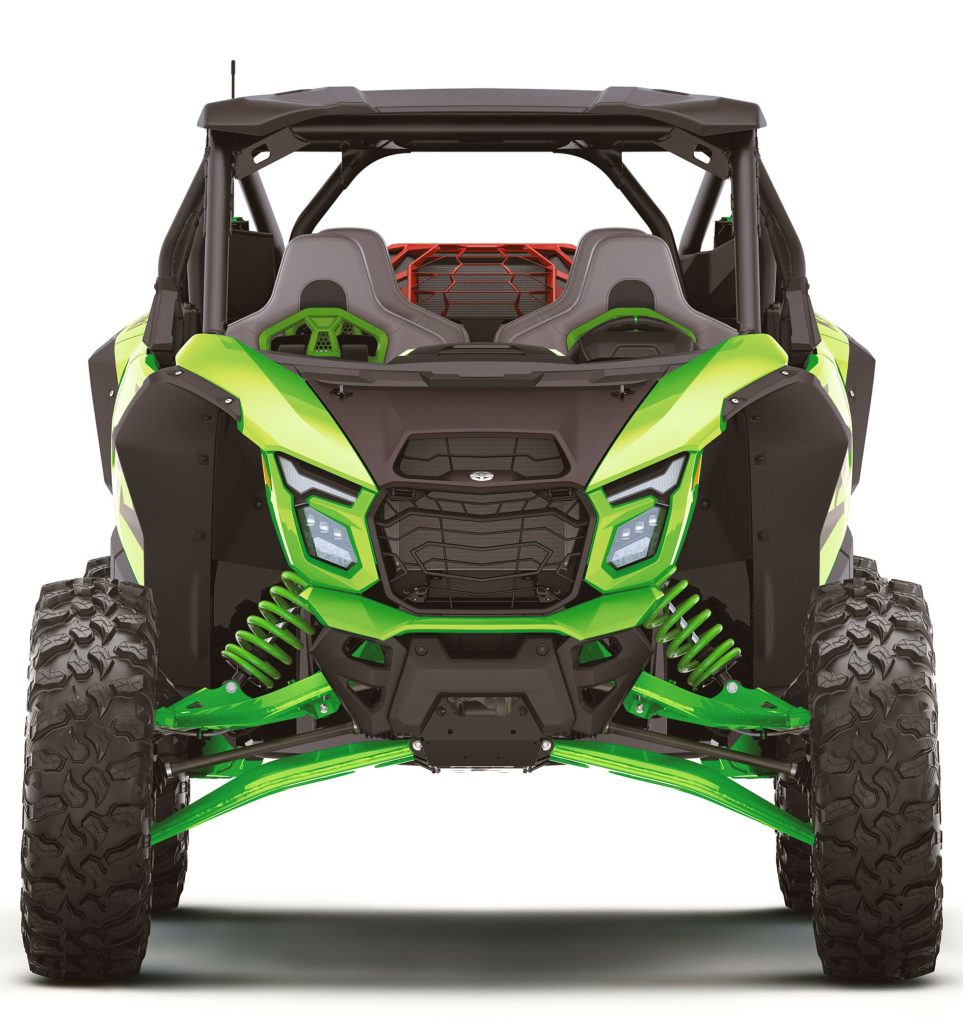
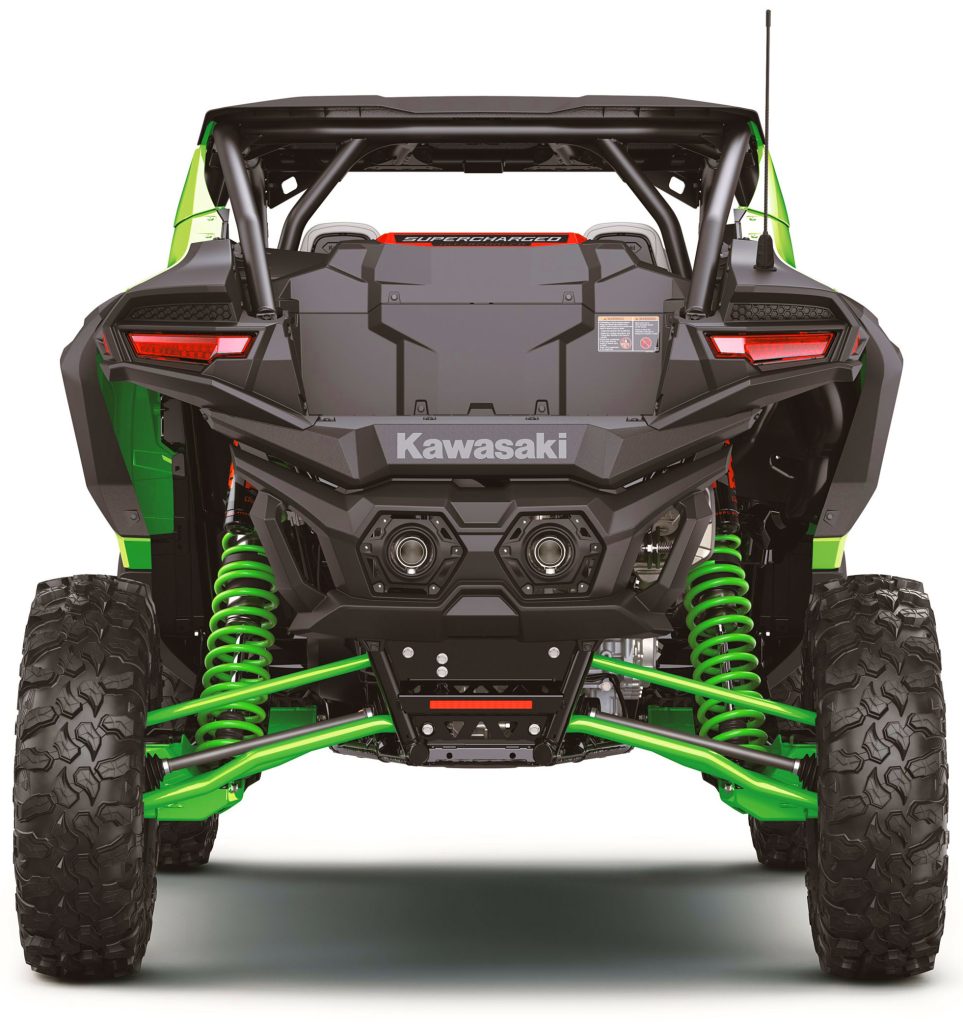
Chassis & Styling
Kawasaki has borrowed heavily from the Teryx KRX platform here for both styling and chassis construction. If you were not more informed, you might think you’re actually looking at the standard KRX model. Unless they were sitting next to each other, it would be difficult to see any major differences… But if they were sitting next to each other, you’d notice a much larger presence with the H2 platform!
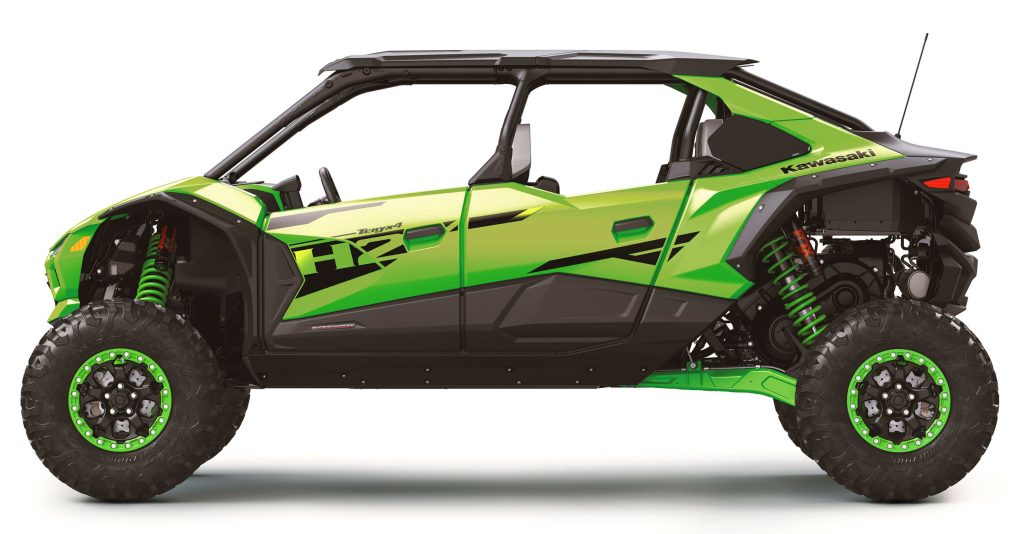
The first thing I noticed was that they dropped the arched ROPS system and lowered the rear row head room. The cage now looks much more flat and, in my honest opinion, better. It looks much more aftermarket! The c-pillar plastics come all the way up to the roof line muck like a Polaris Pro-R and Can-Am Maverick R. The engine and CVT air intakes are once again in the c-pillar area. Kawasaki went as far as to say “snorkle intakes” but they are in the same place as the KRX. They do not go to the roof line nor have a turn down.
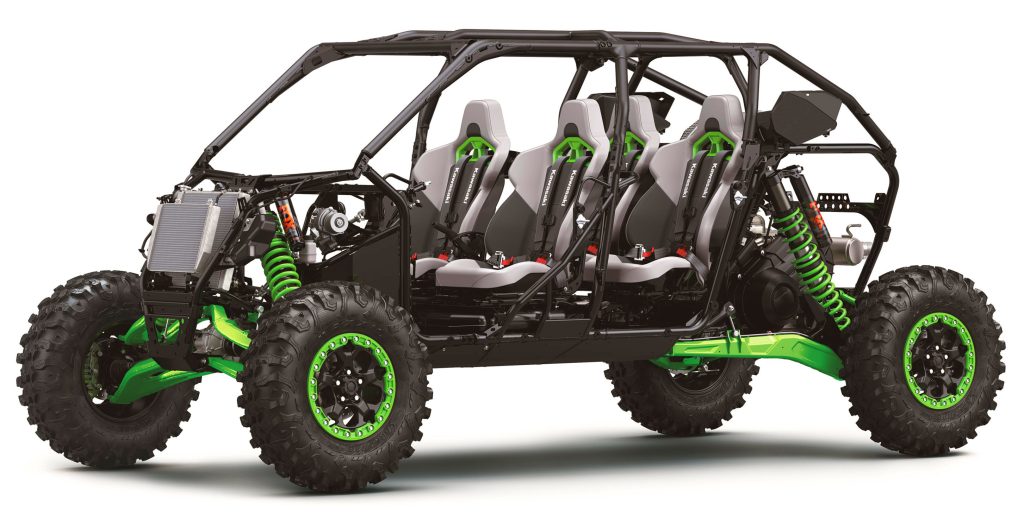
Kawasaki has made multiple education points to say that they’ve made the chassis more rigid. Kawasaki says, “The frame’s sturdy construction was developed using advanced dynamic rigidity analysis to achieve maximum strength with minimal weight. This detailed analysis resulted in an optimized frame design that requires very few gussets, including at the top of the A-pillars to maximize the driver’s visibility. Thicker wall tubing reinforces key areas like the engine and suspension mounts, along with other high-stress points.” I will say, every KRX we’ve driven has been a solid unit, so I expect the H2 to be the same. The chassis also includes the integrated steel front wheel well liners from the KRX. Nice! It is also nice to see additional spines added to the length of the passenger compartment. More safety never hurts!
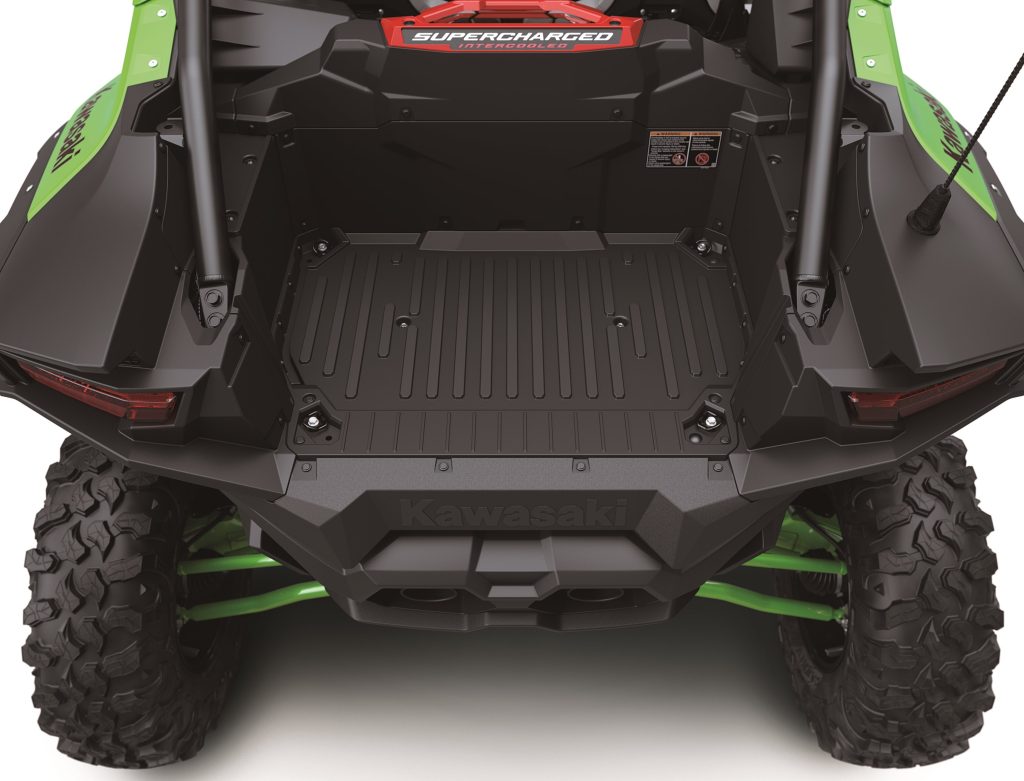
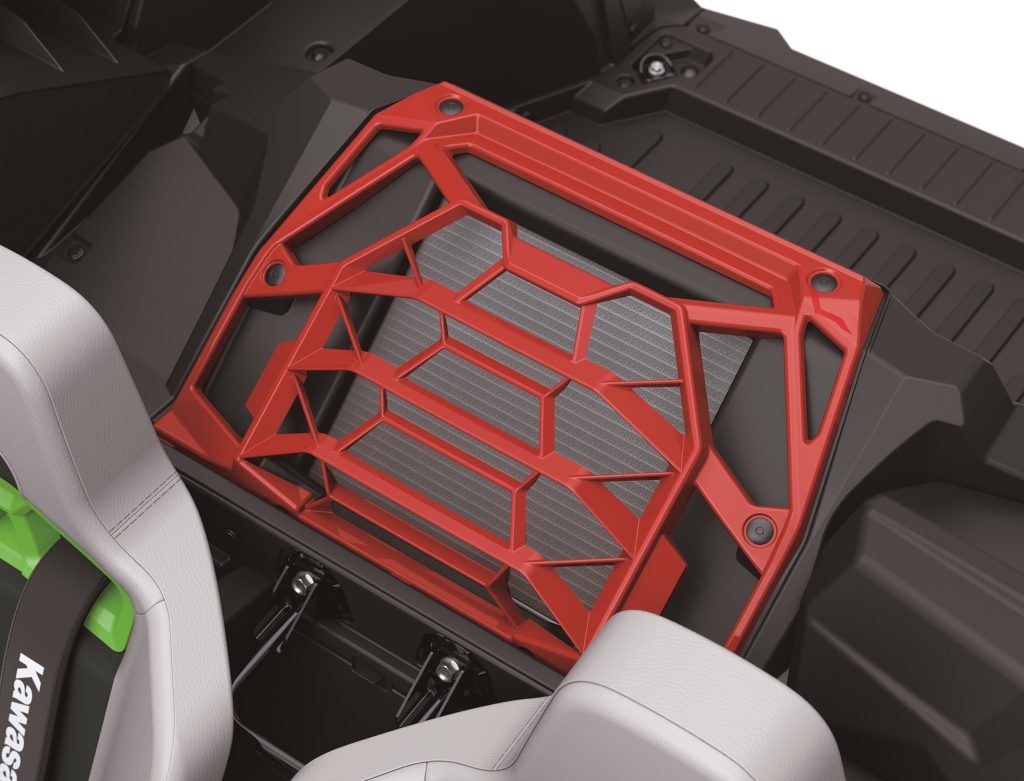
The rear of the H2 is pretty standard fair and is a usable 14.6″ x 33.1″ x 9.1″ with 300lb capacity. The straight sides and flat-ish top will make an easy design for the aftermarket trunk covers. New is a intercooler located between the rear seats with a noticeable red grill. I dig it. I’m curious on how much air flow is reduced with the 5-seat variant…
Interior
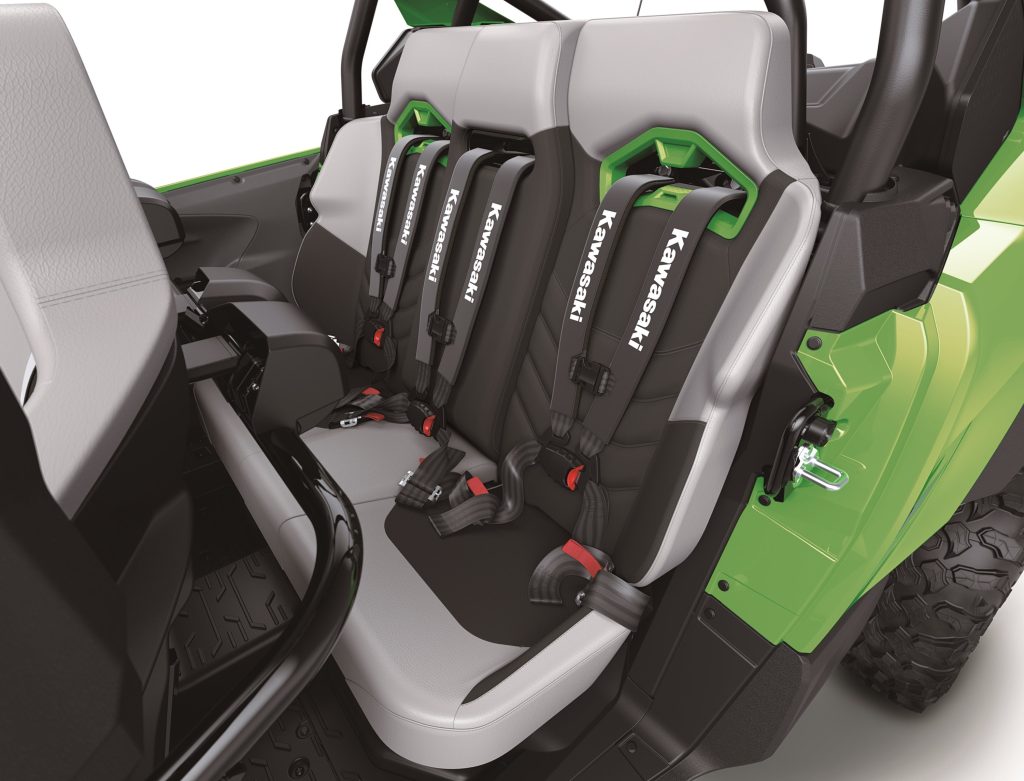
Speaking of 5-seat variants, the Teryx 4 H2 also comes as a Teryx 5 H2 which swaps out the rear bucket seats for a contoured bench seat and includes a fifth 4-point seatbelt/harness. The 5-seat model commands a $500 premium, but basically the same or cheaper than swapping out the rear seats yourself with an aftermarket solution. I’d recommend this option for families that plan on keeping the seats stock. If you’re planning on upgrading the seats to aftermarket suspension seats etc, then I’d save the money and get the 4-seat variant.
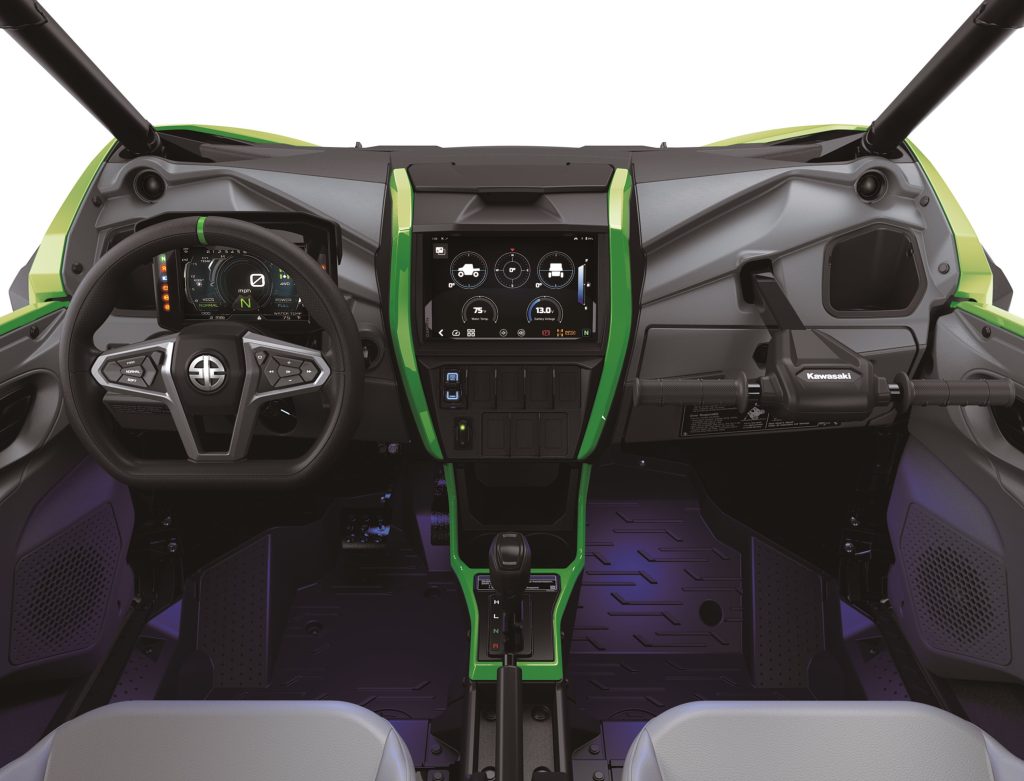
The cockpit of the Teryx 4 H2 is similar but updated from the KRX. There is still tons of room and everything is cleanly laid out. With the Deluxe trims, you get a sporty steering wheel with flat bottom and convenience buttons for the navigation and infotainment. The wheel does tilt but does not telescope like a Polaris Pro R. The shifter is simple with H/L/N/R and a manual parking brake is situated between the front seats.
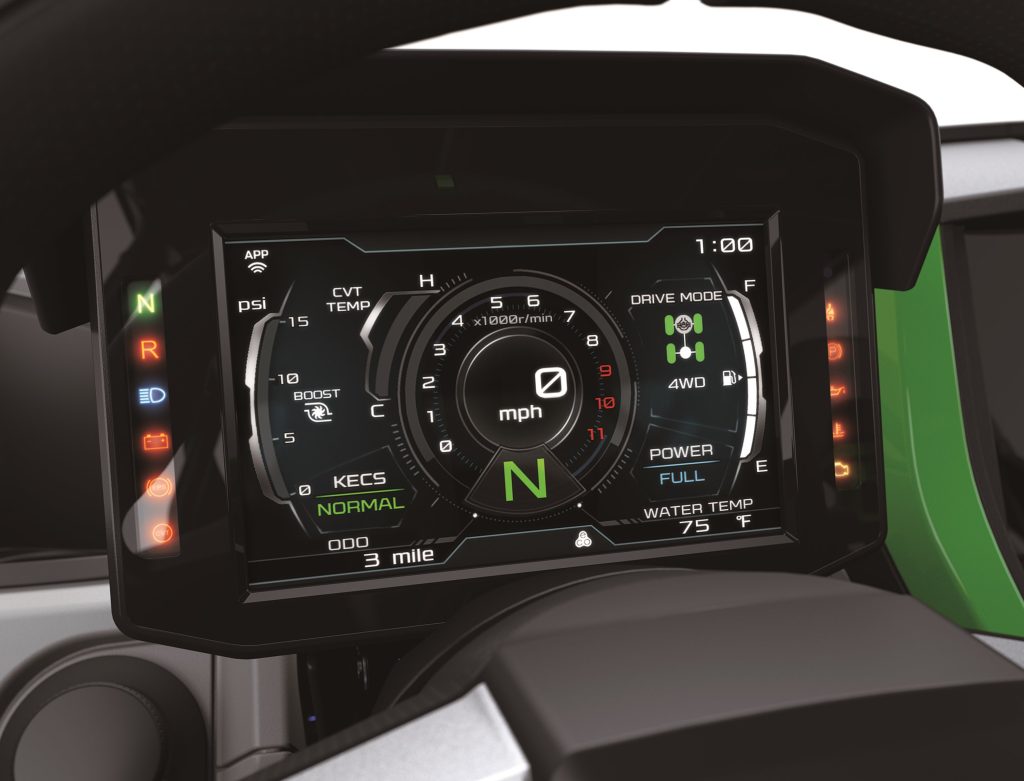
The gauge cluster is probably one of the prettiest and most tech-y looking in the industry. A full 7″ color TFT panel is customizable and displays all needed information. It has Bluetooth to connect to the Kawasaki app as well.
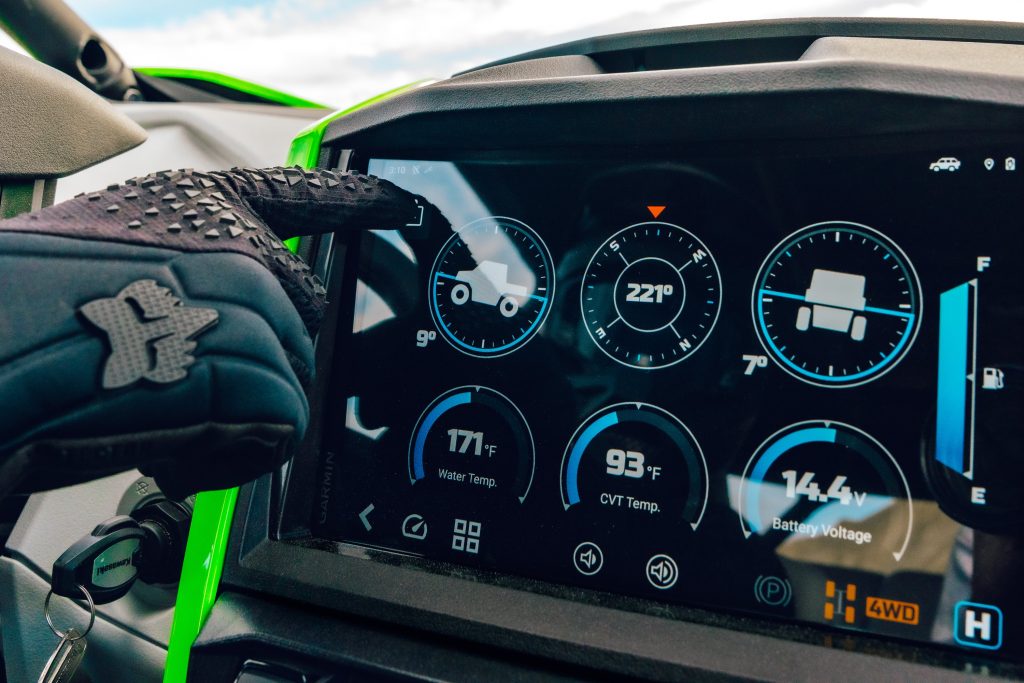
The Teryx H2 Deluxe trims also get the 10″ Garmin Tread integration for navigation, sensor display, and infotainment. Paired with this solid unit is 4 6.5″ speakers, no subwoofer. Below the 10″ screen, you’ll find eight switch locations with one pre-occupied with the drive power selection switch. This switch allows you to select power delivery to include Full Power (100%), Medium Power (80%), or Low Power (60%). This will be great when you have to speed limit or are crawling and want to maintain throttle composure. Below that switch is the drive select for 2WD, 4WD, and front-locked 4WD. I like that the switch bank also includes the raised dividers and is wrapped in accent plastics. Above the center cluster is a storage area.
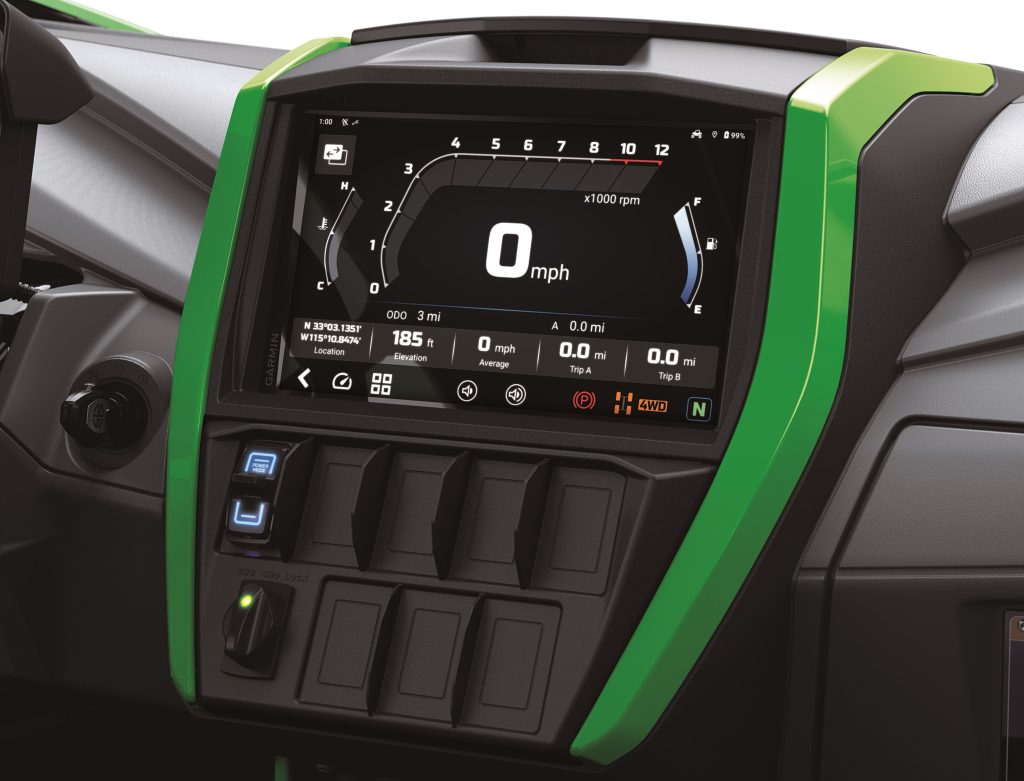
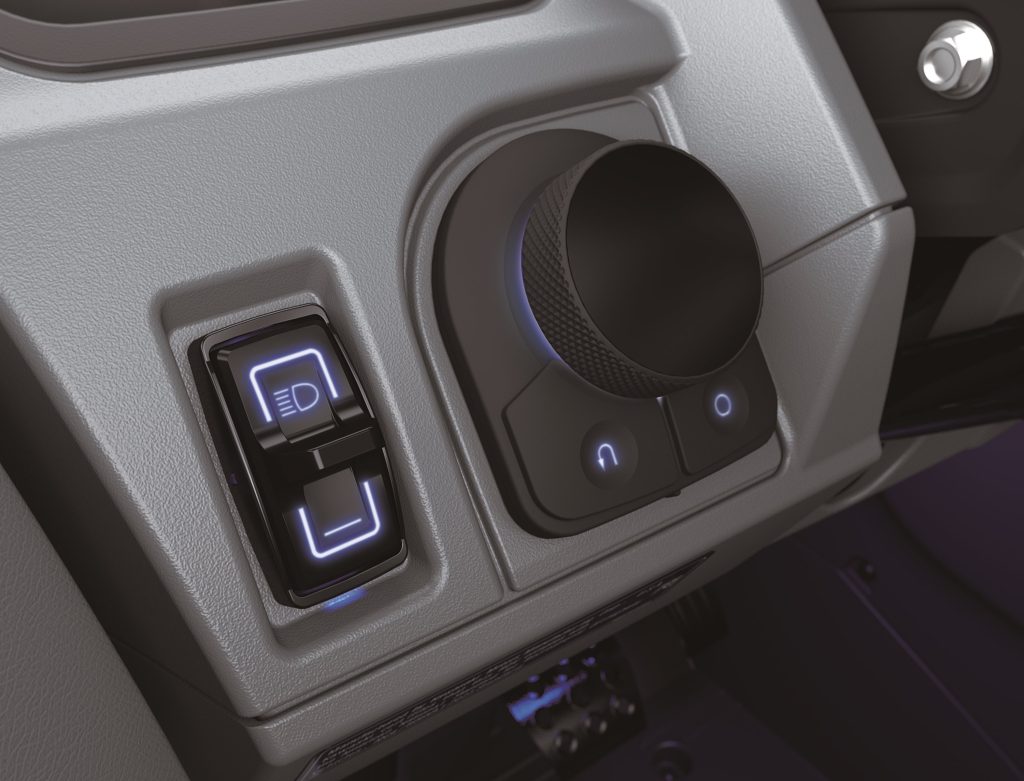
On the left side of the steering wheel is a new control dial next to your light selector switch. This dial controls items in the infotainment, but also is used in a new camera zoom function where it will zoom in on the center of the screen… Not sure why this was included, but hey, something new!
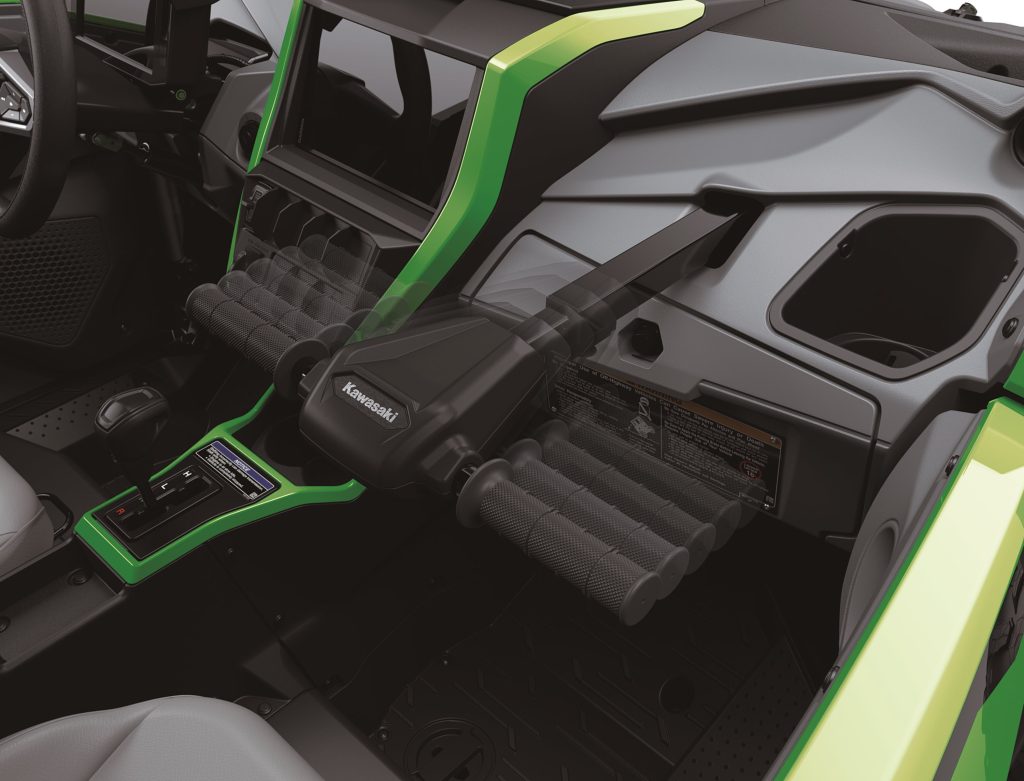
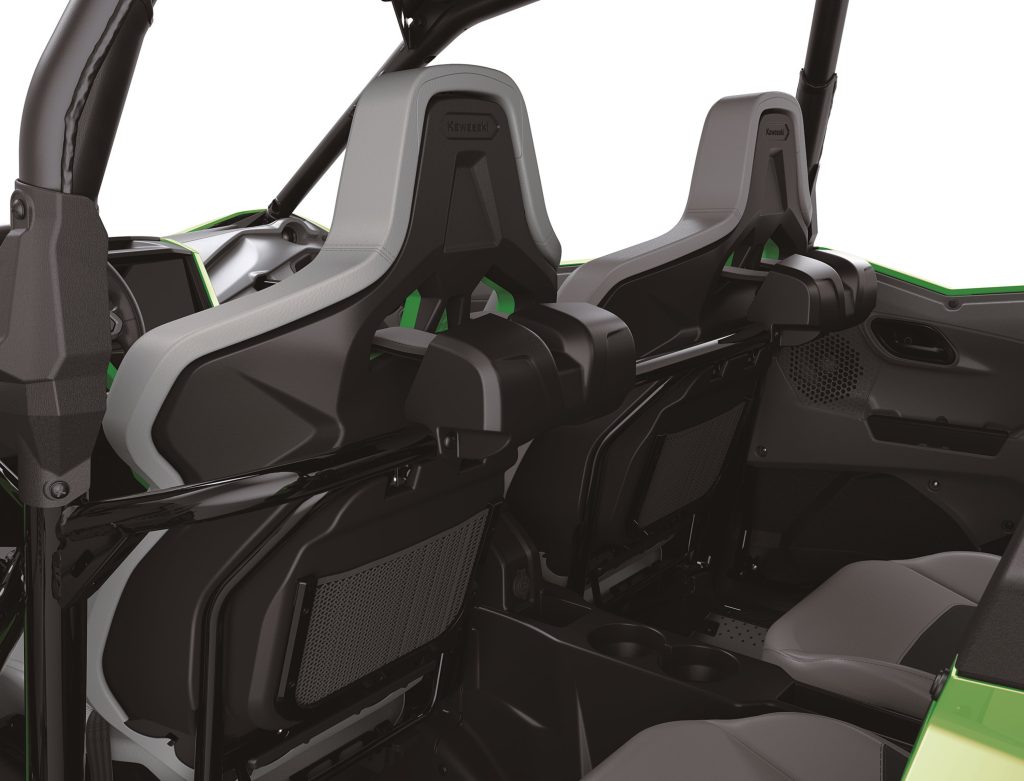
Front passengers have a nice new cup holder in the dash along with an adjustable T-bar style oh-sh!7 handle. Rear passengers have the standard ROPS-integrated seat bar to hold onto along with a couple cup holders in the center console, along with a little storage area (if in a 4-seat variant).
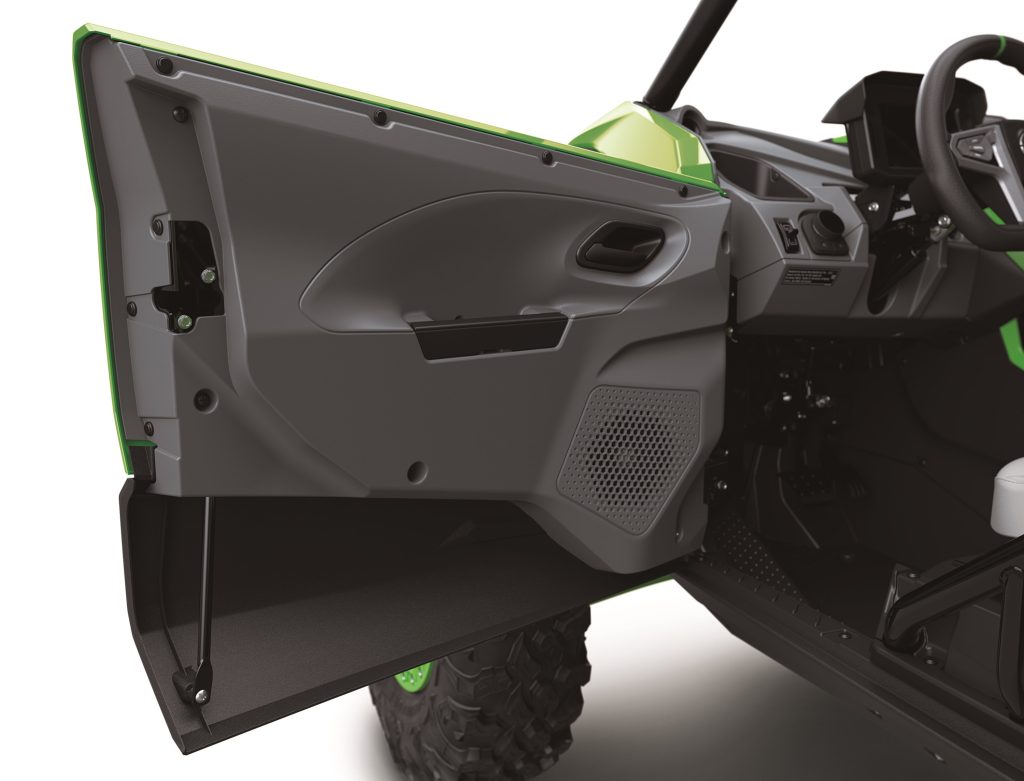
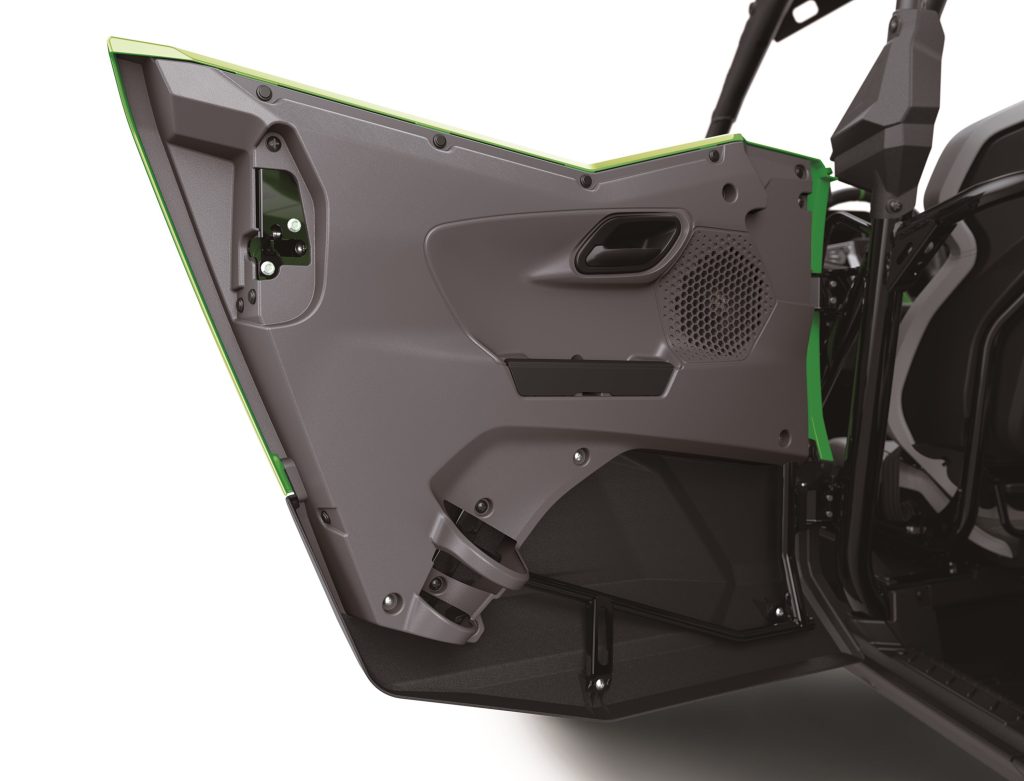
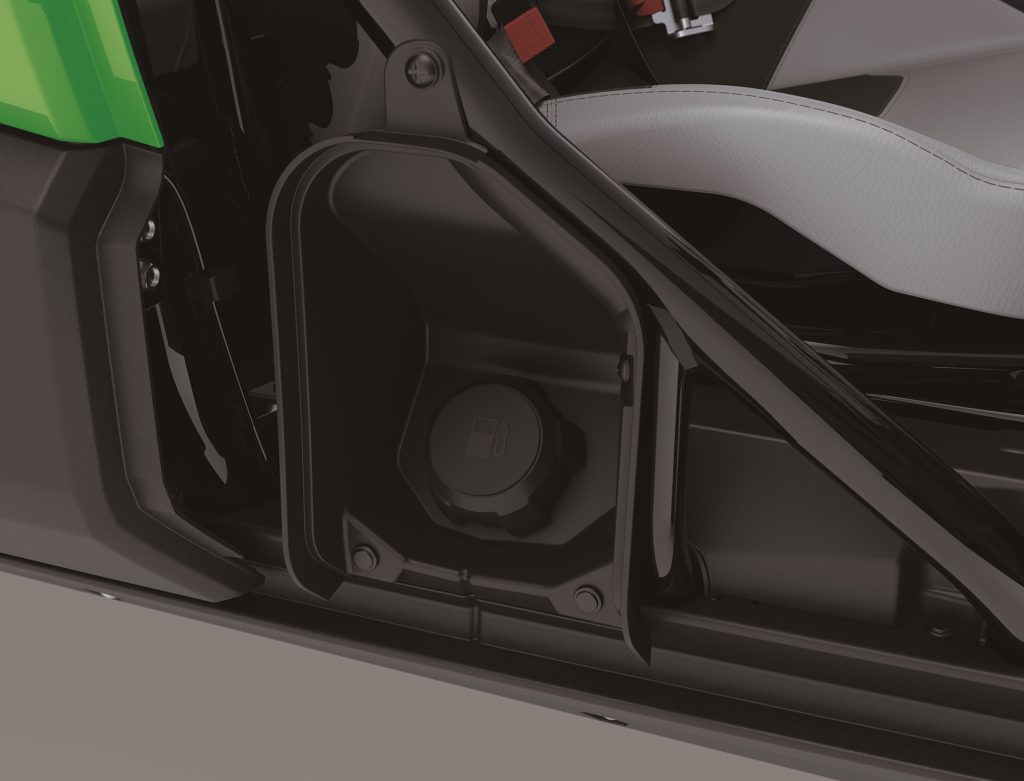
The doors are solid and have a full molded inner liner with arm wrest, speaker grill, automotive style door latches, and rear doors feature a bottle holder. The front doors don’t have this due to having fuel tank access located there. I like that Kawasaki hides the fuel behind the door, preventing mud buildup.
Supercharged Powertrain
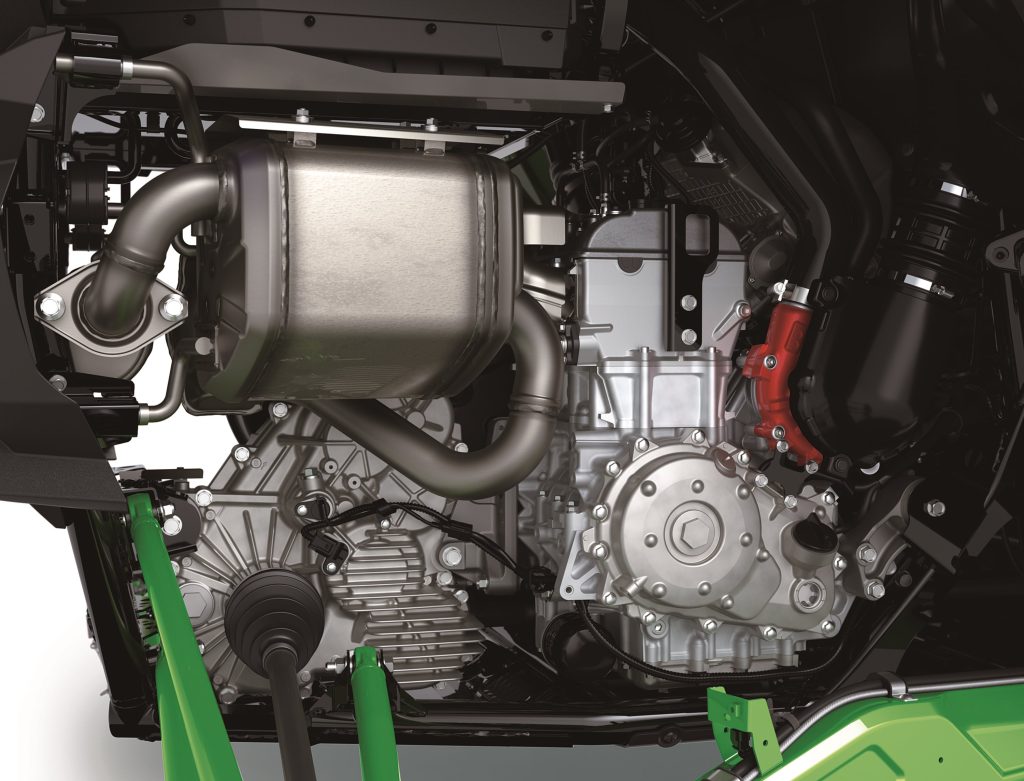
Now that we’re passed the boring stuff… the exciting new stuff! The 2026 Kawasaki Teryx 4 HD is powered by an all-new engine inspired by the 2-wheeled distant Kawi cousins. This new 999cc supercharged inline 4-cylinder engine puts out 250hp* and is paired to the reliable Kawasaki CVT with centrifugal clutch. You’ll notice that all presentations of 250 horsepower come with an asterisk. This is because Kawasaki chose to dyno this powerplant using the ISO Standard 4106, not the commonly used SAE standard used in North America. This is common with their motorcycles as well. What this means to you is that you should think of it as … “almost 250hp.” No big deal, just technicalities. It will remain to the aftermarket tuners to tell us how this 250hp compares to stated 240hp of the Maverick R and the 225hp of the RZR Pro R.
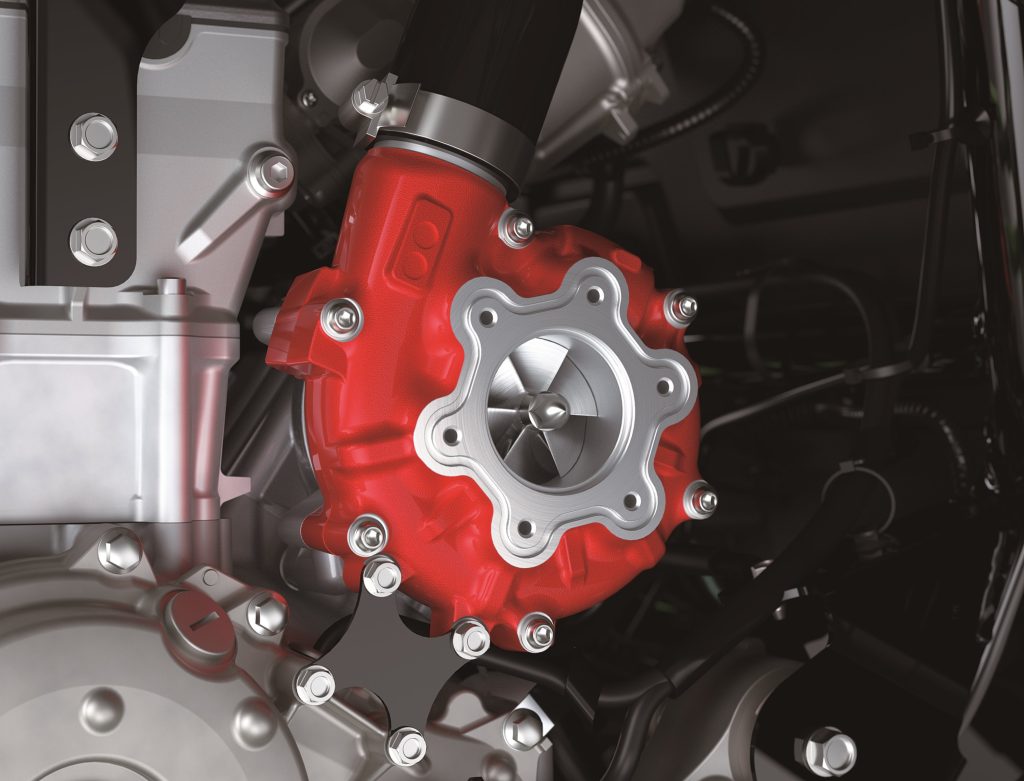
The 2.72″ supercharger impeller is a mirrored design based off of the one used in the Kawasaki Ninja H2 SX hypersport motorcycle. That motorcycle also has a 999cc inline 4-cylinder engine. This is a 6 to 12 blade design CNC’d from aluminum that spins at nearly 130,000 rpm at top speed. We can be anything but smitten with the choice to highlight the supercharger in red… it’s a nice touch!
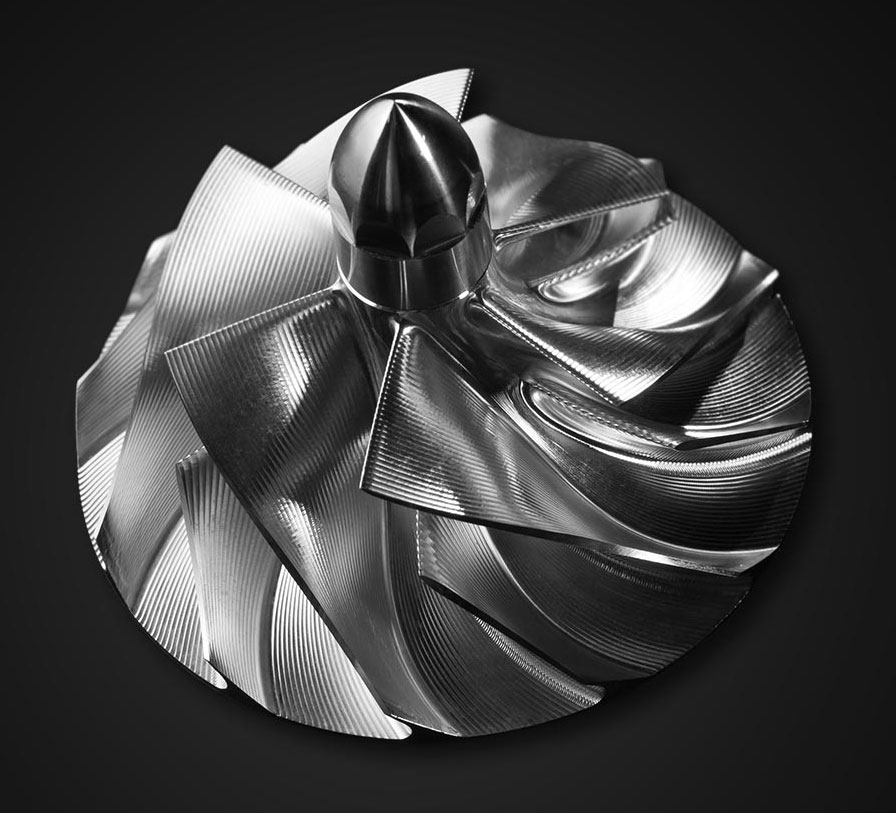
After the supercharger, the air hits an intercooler located center behind the rear seats and has a dedicated 3,000 rpm cooling fan that reportedly assists in reducing heat buildup by 40%. The new engine also has an electronically controlled blow-off valve. Teamed up with electronically controlled dual valve system, the new H2 platform can build smooth and consistent power. Additionally the new H2 engine has four 40mm throttle bodies instead of the standard single throttle body. Teamed all of that with both 10-hole upstream and 12-hole downstream injectors and you’re looking at a performance that can be managed from idle and throughout the power band by activating the upstream injectors above 5,000 RPM.
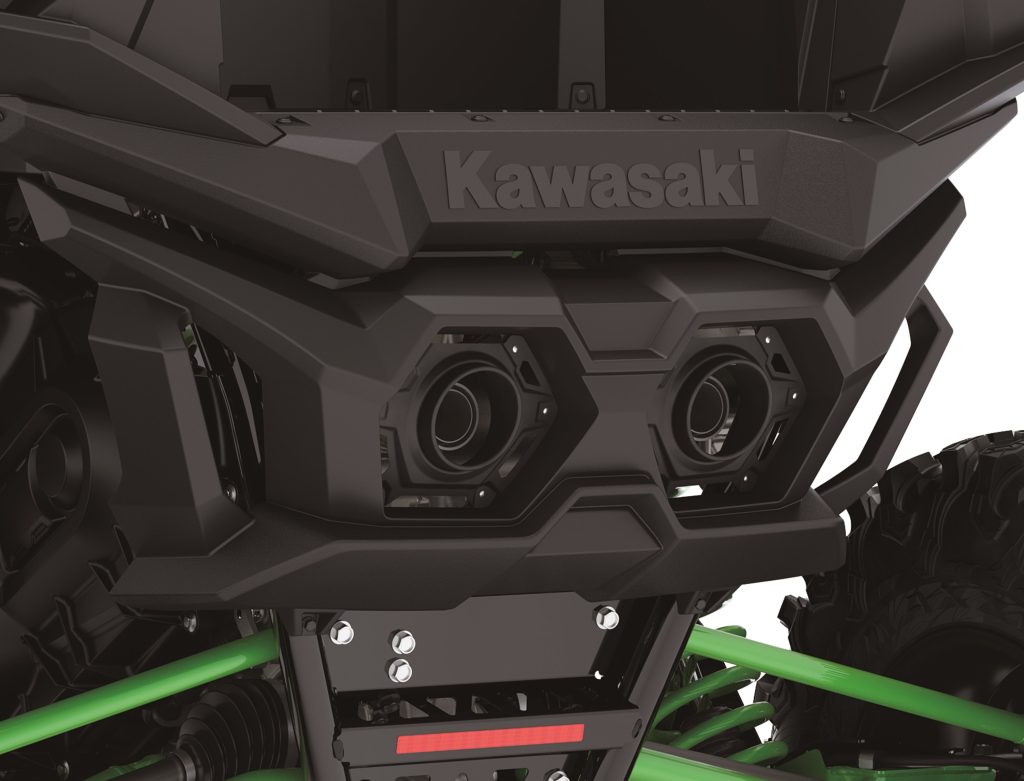
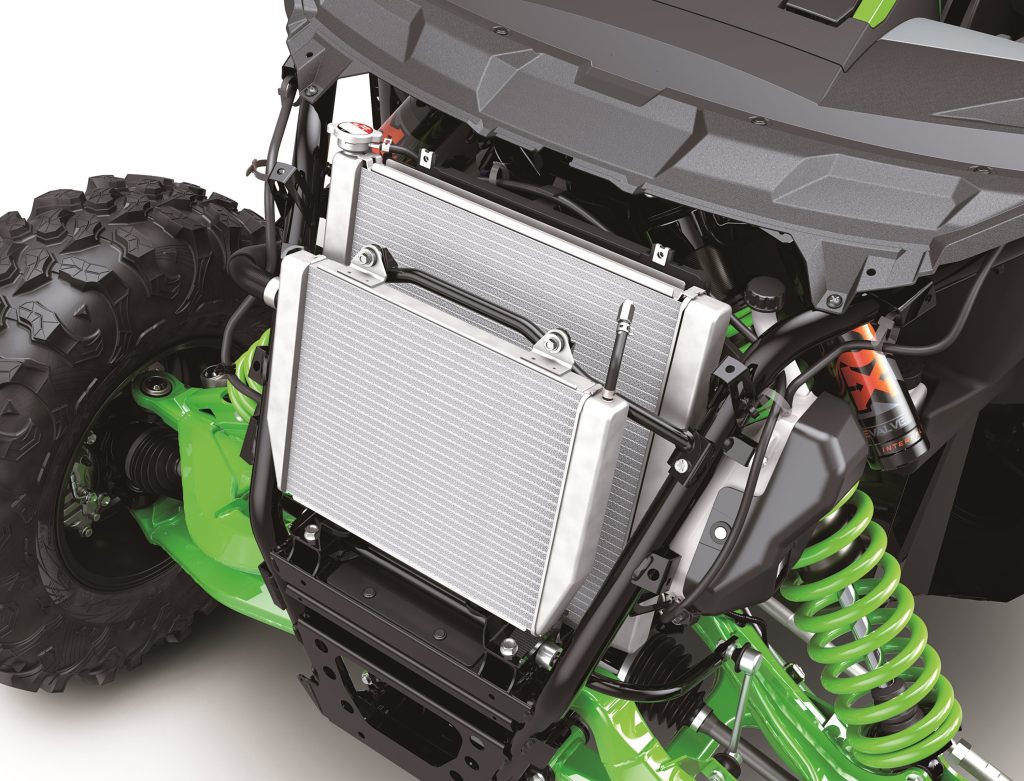
Upon exiting the engine, the exhausted air flows through an updated stainless steel cat’ and muffler featuring a 4-2-1 pre-chamber silencer layout and exits out of a dual exhaust centered and below the bed. Additional cooling for this supercharged beast is dual radiators at the front of the Teryx. The first radiator measures 11″x13″ and the second stacked radiator measures 15.75″ square. Also assisting with keeping this beast under temp is an 18-row water cooled oil cooler located in front of, and below, the engine.
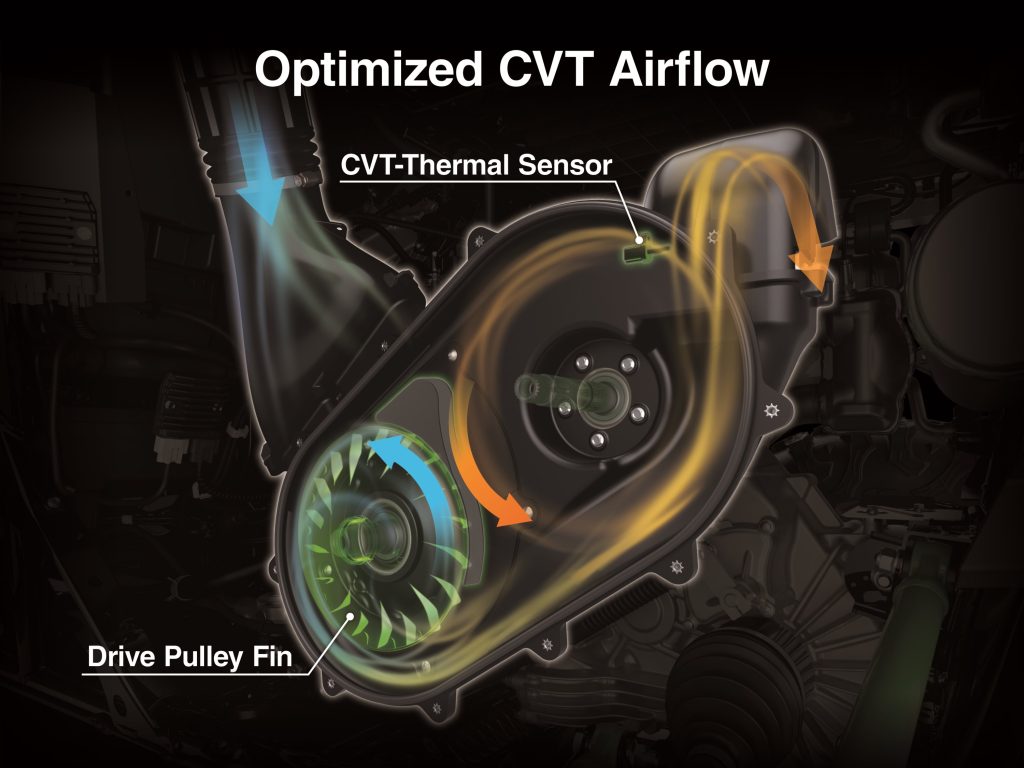
Kawasaki has chosen to stick with their KRX-proven CVT transmission that features a centrifugal clutch. This design has been updated with additional cooling capabilities and thermal management for the increase power band. These factory clutches have had their ups and downs, but for the most part, the community has taken care of any upgrades and tuning needs in this department.
Suspension
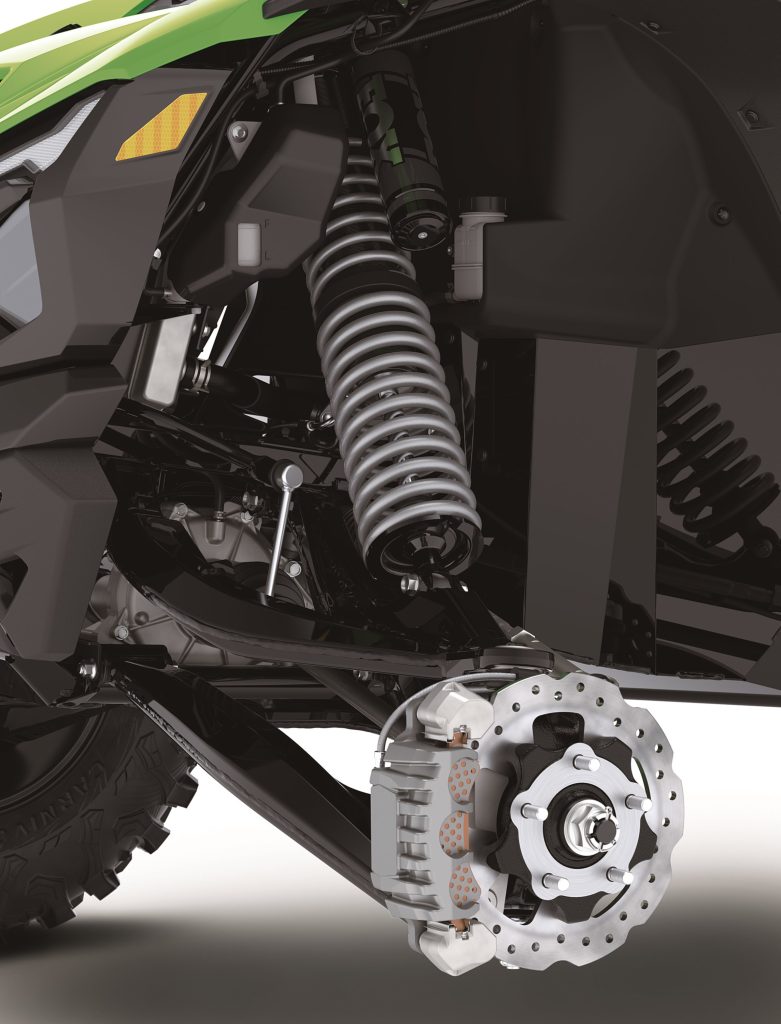
The 2026 H2 platform does not bring much to the table as far as suspension innovation. The design is essentially the same as the KRX platform but wider to 74″, up from the KRX’s 68″. Kawasaki chose to keep the top arm-mounted shock location on the front suspension and 4-link trailing arm design. Honestly this isn’t a huge deal, but we would have liked to see team green step things up in this area to compete more with teams yellow and blue’s suspension advancements.
The shocks are FOX 3.0 Live Valve with internal bypass and piggy back reservoirs on all four corners; nice! Unfortunately because Kawi didn’t push the suspension forward, these are the same KECS controlled units that only have compression damping. With this much horsepower, having Live Valve X2 with dual valve control would have been appropriate in our opinion.
Wheel travel has been increase with the new long travel dimensions. The 2026 Teryx H2 platform has 23.2″ for front wheel travel and 24″ of rear wheel travel; up from 18.6″ and 21.1″ of the KRX platform. Ground clearance is up to 16.5″; up from KRX max of 15.2″ of ground clearance and thanks to the larger 33″ tires. Front-lower a-arms, trailing arms, and radius rods are all arched for high clearance as well.
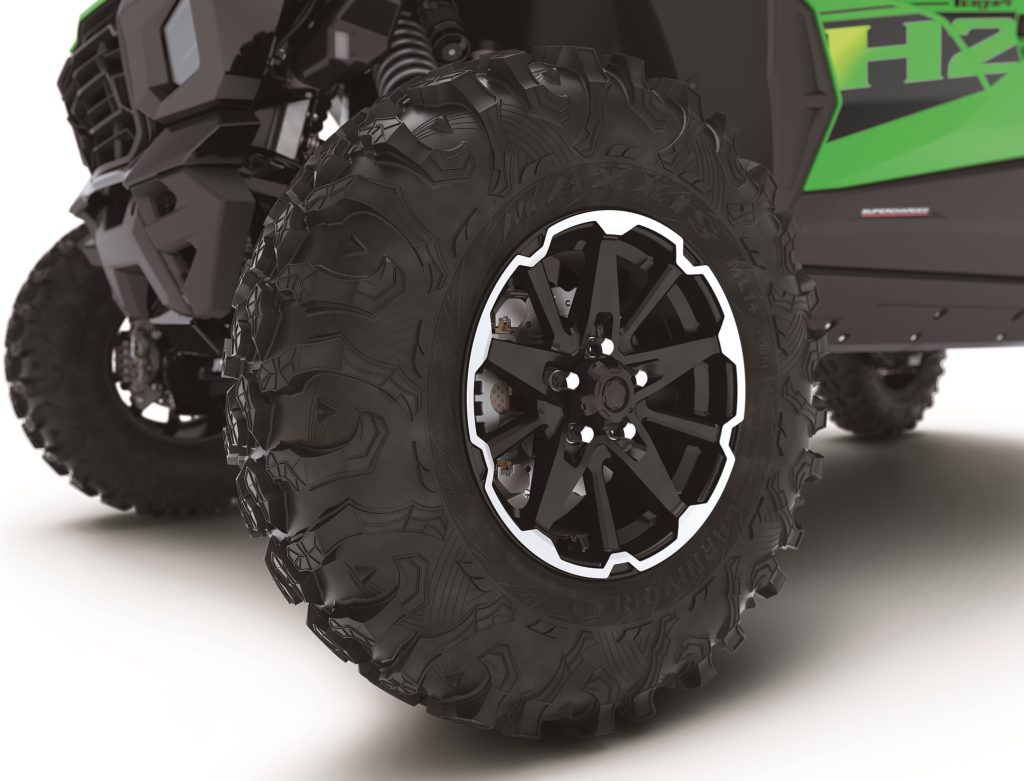
Kawasaki did upgrade their wheels and tires with this release. The 2026 H2 platform will be running 5-lug 16″ aluminum bead-lock wheels wrapped in Maxxis Carnivore Plus 33x10r16 in all four corners. We don’t have any confirmation on the lug spacing at this time. To stop this 2,500lb beast are 270mm dual hydraulic disc brakes with 3-piston calipers in the front, 2 in the rear.
The 2026 Teryx H2 Deluxe eS gains 400lbs of weight over it’s KRX brethren, weighing in at just over 2,500lbs! Additionally the foot print of the H2 platform is a large 159.4″ x 74″ x 71.5″. While large, this is still shorter than the 165.5″ long Polaris Pro R 4 and the 175″ Can-Am Maverick R Max.
Steering is par for course with the powered Kawasaki rack-n-pinion, but the turning radius goes up 1.5′ from the KRX 4. The 126″ wheelbase requires 24.9′ to turn around! Guess we’ll start practicing our multi-point turns now… The H2’s wheel base is 16.6″ shorter than the Maverick R Max and 7.5″ shorter than the Pro R 4.
Conclusion
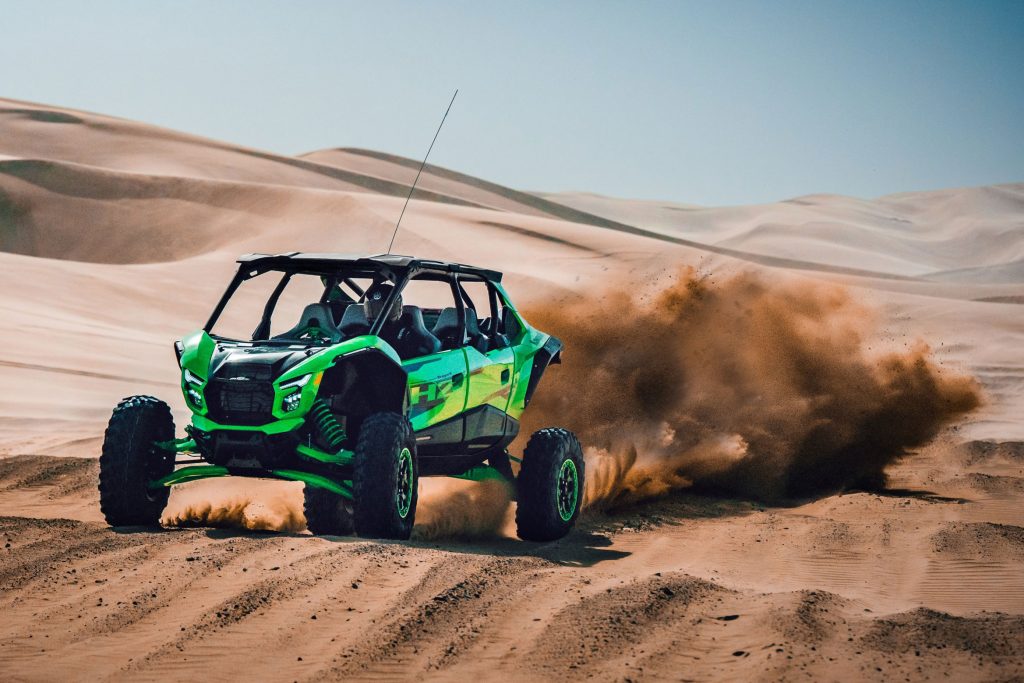
The 2026 Kawasaki Teryx H2 platform launch is finally here! No more speculating, no more rumors… just people complaining they didn’t release a 2-seat option or bottom a-arm mounted front shocks or a DCT. We think this is a great release from Kawasaki and shows they can deliver on customer demand. Sure it might not have every ground breaking thing on it, but it leaves the door wide open for progression and innovation. The aftermarket is going to love this new power plant and will give team green a new shot at being competitive in desert racing!
The 2026 Teryx 4 H2 starts at an MSRP of $37,199 USD… but we believe it’s worth upgrading to the Deluxe eS trim for $43,199. The Teryx 5 trim only makes sense if you’re a family that doesn’t plan on upgrading the seats to aftermarket; which there’s plenty of those customers out there. If you’re a racer and will be building a new H2 powered race car, get the base model and put that $5k into the shock tunes!
Please make sure to drop into our social channels at Facebook, Instagram, or YouTube and let us know your thoughts on the all-new supercharged platform from Kawasaki!
You might also like
More from Annoucements
Segway Launches All-New Super Villain SX20T Hybrid
Segway Powersports launches the all-new 2024 Super Villain SX20T UTV platform including a 235hp gas-only and 330hp hybrid versions!
Fox Releases All-New ECS2 UTV Shock Cooler
Fox Factory, Inc. has just released their all-new ECS2 UTV Shock Cooler system! This is an after-oem upgrade and replaces …
Tensor Tire Enters Paddle Market
Tensor Tire, most well known for their desert-focused DS "Desert Series" and DSR "Desert Series Race" tires, has today launched …
